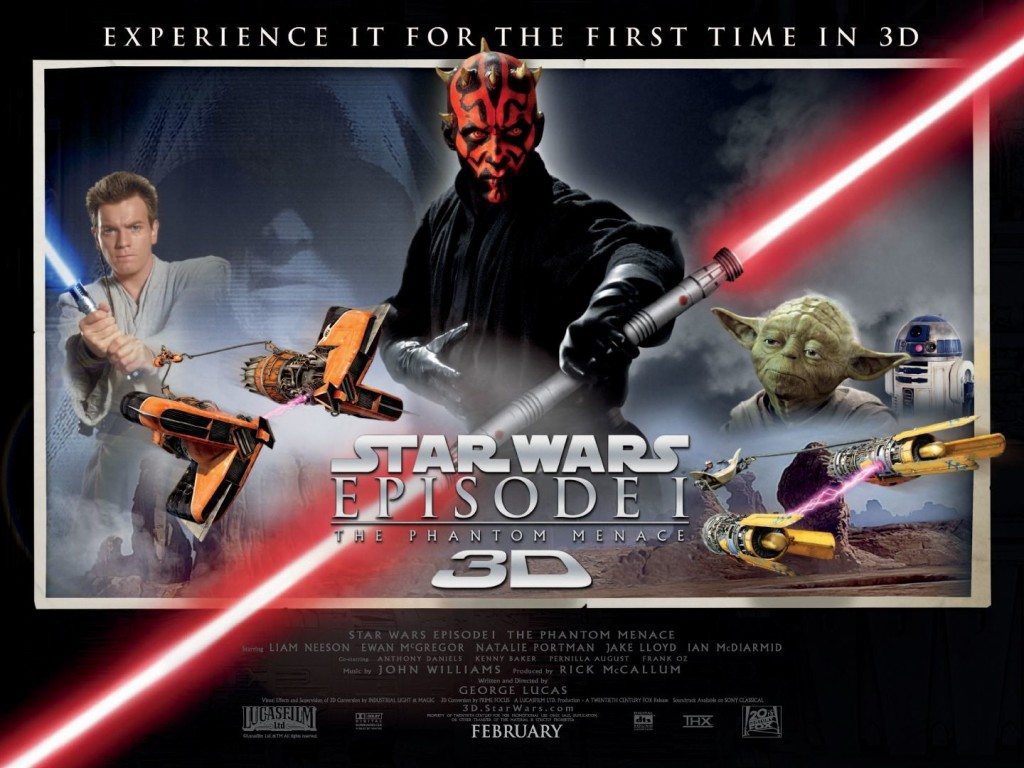 As the world approached the third millennium, Star Wars movie fans were getting excited. After a decade and a half of waiting, we were finally going to get more details about the ?back story.? What we were about to find out would bewilder and confuse us a bit, and many would be rather disappointed. Many critics would set up Jar Jar Binks as a symbol of all that was wrong with the ?prequels.? Perhaps the expectations of many fans were not exactly what George Lucas had in mind when he decided to take on three more movies after a long hiatus from the saga.
As the world approached the third millennium, Star Wars movie fans were getting excited. After a decade and a half of waiting, we were finally going to get more details about the ?back story.? What we were about to find out would bewilder and confuse us a bit, and many would be rather disappointed. Many critics would set up Jar Jar Binks as a symbol of all that was wrong with the ?prequels.? Perhaps the expectations of many fans were not exactly what George Lucas had in mind when he decided to take on three more movies after a long hiatus from the saga.
In 1983, Lucas admitted that the constant worry about Star Wars had taken a toll on him, and he wasn?t sure when he would be able to get back to it. At that point, he was just glad to leave that galaxy ?far, far away.? (See the 2012 article ?Star Wars Day memory: When George Lucas wasn?t feeling The Force.?) For many years, fans were unsure George would ever get back to his high-maintenance baby and, when he finally did get back to her, many fans found the movies, especially Episode 1, rather? infantile.
Perhaps the main problem is that, while Star Wars fans got older, the movies were designed to capture a younger audience. Lucas recently admitted?that he designed Jar Jar after the Disney cartoon character Goofy. An appeal to a younger audience did not begin with Phantom Menace. The Return of the Jedi included cute, cuddly creatures (Ewoks), and was not as dark as originally planned. Many argue that Lucas was more interested in selling toys than telling a good, mature story.
C.S. Lewis once wrote, ?A children’s story that can only be enjoyed by children is not a good children’s story in the slightest.? Are the Star Wars prequels children?s stories only a child would like, or is there good reason for adults to appreciate them, too? I would argue there is. Although there are elements which (intentionally) appeal to children, there are also some themes which are more mature in nature. I maintain that if we ?forgive? Lucas for including ?infantile? elements into the stories, we can appreciate the more sophisticated themes which are also there.
 The movie begins with a conflict between the Trade Federation and the Planet Naboo. The opening scrawl mentions a dispute about taxes, but gives very limited details. Lucas leaves the particulars for geeks to discover in other Star Wars sources. The 2001 book, Cloak of Deception, gives the back story to the back story, filling in the details about the Trade Federation, which is a huge corporation controlling many of the outer rim planets. The tyrannical tactics employed by the Federation lead to opposition by pirates and terrorists, which furthers the Federation?s justification for arming themselves and creating an ever-larger army. The Republic is willing to allow this as long as they are able to tax the trade routes. The Senate has become corrupt, with little concern about the planets under the thumb of the Trade Federation. And, of course, Darth Sidious is manipulating things behind the scenes in order to gain control of the galaxy. Naboo, rich in plasma needed for weapons, is central to his plans.
The movie begins with a conflict between the Trade Federation and the Planet Naboo. The opening scrawl mentions a dispute about taxes, but gives very limited details. Lucas leaves the particulars for geeks to discover in other Star Wars sources. The 2001 book, Cloak of Deception, gives the back story to the back story, filling in the details about the Trade Federation, which is a huge corporation controlling many of the outer rim planets. The tyrannical tactics employed by the Federation lead to opposition by pirates and terrorists, which furthers the Federation?s justification for arming themselves and creating an ever-larger army. The Republic is willing to allow this as long as they are able to tax the trade routes. The Senate has become corrupt, with little concern about the planets under the thumb of the Trade Federation. And, of course, Darth Sidious is manipulating things behind the scenes in order to gain control of the galaxy. Naboo, rich in plasma needed for weapons, is central to his plans.
Just before the movie came out, George Lucas revealed Darth Sidious is the title character; he is The Phantom Menace.?
Most of these details are not found in the movie, but the themes of corruption and manipulation are clearly portrayed and understandable, even if we are not given the geeky details. These subjects are far from infantile, even if how they are presented may be palatable for younger audiences.
 Another more sophisticated theme in the movie has to do with the main female protagonist. Unlike Princess Leia, who is a rather one-dimensional character?in the original Star Wars film, Queen Padm? Amidala is more than the stoic persona she presents?when she puts on the royal clothes. She can be hard-nosed and compassionate, majestic and humble. And her youth unexpectedly veils a wisdom beyond her years. She is not the stereotypical ?damsel in distress,? but neither is she the anti-traditional-Disney-princess Leia was for most of the original trilogy. Children can dress up her doll in Naboovian queen?s attire, but everyone can admire there is more to her than that.
Another more sophisticated theme in the movie has to do with the main female protagonist. Unlike Princess Leia, who is a rather one-dimensional character?in the original Star Wars film, Queen Padm? Amidala is more than the stoic persona she presents?when she puts on the royal clothes. She can be hard-nosed and compassionate, majestic and humble. And her youth unexpectedly veils a wisdom beyond her years. She is not the stereotypical ?damsel in distress,? but neither is she the anti-traditional-Disney-princess Leia was for most of the original trilogy. Children can dress up her doll in Naboovian queen?s attire, but everyone can admire there is more to her than that.
Not everybody admires Jar Jar Binks. But, besides being comic relief, I have always found that there is a purpose for him in the story. Jar Jar is an irritating goof up. But Qui-Gon Jinn and Queen Amidala both found him useful. Without him, Obi-Wan and Qui-Gon would have never discovered the Gungans, and a way to the palace so that they could liberate the queen. Later, Queen Amidala would have not discovered the ?sacred place,? where she was able to enlist the Gungans? help to fight the Federation. Jar Jar bungled his way through the battle, but, with the help of his new-found friends, he came out victorious with them. Jar Jar shows there is a place and purpose for all of us?especially those of us who are clumsy and are far from having Jedi reflexes.
I haven?t even touched on Anakin or his mother? or his miraculous birth? or the Midi-chlorians. I?ll leave it to you to decide if there are some worthwhile non-infantile themes to think about when it comes to them. We have been promised there will be no Midi-chlorians in The Force Awakens. I am sure there will be some worthwhile things for children and adults in the coming movies?no matter what the critics have to say about them. I, for one, will be looking for them.




